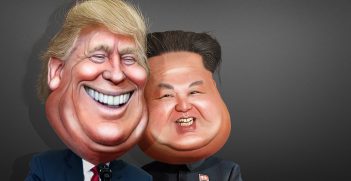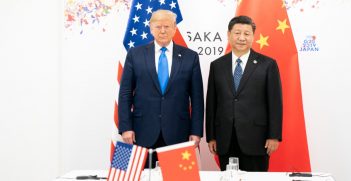The US Killed INF, Russia Buried It, China Will Not Disinter It

The end of the first disarmament agreement of the nuclear age will almost certainly be accompanied by American pressure on allies to host US intermediate range missiles.
The Intermediate-Range Nuclear Forces (INF) Treaty lapsed on 2 August, six months after President Donald Trump suspended US participation and gave notice of withdrawal. In their joint statement at the signing of the treaty on 8 December 1987, Ronald Reagan and Mikhail Gorbachev affirmed “their solemn conviction that a nuclear war cannot be won and must never be fought.” They added: “This treaty is historic both for its objective – the complete elimination of an entire class of U.S. and Soviet nuclear arms – and for the innovative character and scope of its verification provisions.” As the first disarmament agreement of the nuclear age, INF contributed to the end of the Cold War and ushered in three decades of strategic stability on the European continent. It will be sorely missed.
China and the Asia-Pacific
Reflecting the dominant nuclear arms control architecture of the Cold War, INF was bilateral. Since the end of the Cold War, nuclear dyads have morphed into interlinked nuclear chains. INF was negotiated to counter the Soviet nuclear threat to Europe. The US exit is partly a response to China’s growing challenge to its dominance in the Asia-Pacific.
In 2011, writing as a private citizen, John Bolton argued: “we must either expand the I.N.F. Treaty’s membership or abrogate it entirely so that we can rebuild our own deterrent capabilities.” As National Security Adviser Bolton has steered US policy in his preferred direction. The treaty’s collapse highlights how the Cold War-era weapons governance structures are no longer fit for purpose. In an increasingly polycentric global order, the dyadic nuclear arms control structure can neither regulate nor constrain the choices of other nuclear-armed states.
Thus as a non-signatory, about 95% of China’s missiles are in the INF range, enabling it to target US ships and bases from the mainland by relatively inexpensive conventional means. In testimony to the US Senate Armed Services Committee on 27 April 2017, US Pacific Commander Admiral Harry Harris noted that INF limited US “ability to counter Chinese and other countries’ cruise missiles, land-based missiles.” Without INF restrictions, the US can develop and station ground-launched intermediate-range cruise missiles in Guam, Japan, South Korea and northern Australia that could reach deep into China’s interior and force Beijing to divert significant military resources to defend its homeland.
Yet China’s nuclear stockpile is below 300 compared to over 6,000 Russian and US warheads each. China’s stockpile has remained relatively stable over decades, despite fluctuations in Russian and US numbers, because Beijing has refused to engage in a nuclear arms race. China conducted its first nuclear test 55 years ago. Since then, the global strategic landscape has changed dramatically and China has transitioned from an economically weak country into the world’s biggest economy in purchasing power parity. Its initial nuclear restraint was owing to limitations of resources and technological capability but it has not changed nuclear policy even after acquiring economic and technical capability to do so. The reason is simple. China does not believe nuclear weapons are militarily useable. Rather, they are political weapons to deter nuclear attack and prevent nuclear blackmail. This permits China to adopt asymmetric deterrence postures vis-a-vis the US with significantly lower stockpiles.
Any US deployment of intermediate-range missiles around China’s security perimeter will compel Beijing to institute countermeasures to protect vital security interests, including nuclear assets located deep in its interior. China’s response in turn will trigger readjustments to India’s doctrine of credible minimum deterrence and produce matching readjustments by Pakistan. In a worst-case scenario, all three of China, India and Pakistan will engage in a sprint to parity with one another with a rapid expansion of warhead numbers, missile delivery capabilities and diversified launch platforms. They could even move to keeping a stock of nuclear weapons on high alert just like Russia and the US, multiplying the risks of an accidental nuclear war.
The sensible alternative would be to multilateralise the Cold War bilateral structure of nuclear arms control regimes in order to avoid a free-for-all nuclear arms race and instead anchor strategic stability in arms control agreements. Speaking after the INF’s demise, Trump said he wanted China to be party to any new nuclear pact with Russia. China has steadfastly rejected requests to save the INF by agreeing to trilateralise it, emphasising that its warheads in the low hundreds cannot be compared with US and Russian arsenals in the several thousands.
Speaking to the Conference on Disarmament in Geneva on 6 August (Hiroshima Day), disarmament ambassador Li Song expressed China’s deep regret and opposition to the US withdrawal from the INF. The “irresponsible unilateral” measures meant to give the US a military-strategic edge, Li said, would damage arms control processes and ‘severely undermine global strategic balance and stability’. On the same day in Beijing, Fu Cong, the director of arms control in China’s foreign ministry, cautioned Asia–Pacific countries against permitting INF-range missiles to be deployed on their territory. ‘China will not stand by idly and will be forced to take countermeasures should the U.S. deploy intermediate-range ground-based missiles in this part of the world,’ he said. This was in response to a statement from US Defense Secretary Mark Esper that the US wanted to deploy such missiles to the region ‘sooner rather than later’.
Should Australia host US missiles?
On 5 August PM Scott Morrison ruled out Australia as a base for hosting US intermediate-range missiles. But Bolton is intent on linking the US security guarantee to allied consent to the deployment of US missiles. More than acquiescing to any US requests for basing their INF-range missiles here that will unquestionably contribute to a new nuclear arms race, let alone acquiring our own nuclear weapons, we need to engage in a hard-nosed analysis of the merits of the changing risk–reward calculus of integrating more deeply with the nuclear alliance structure or joining the majority of countries in trying to rid the world of nuclear weapons.
In his State of the Union Address on 25 January 1984, Reagan noted the nuclear emperor had no clothes: ‘The only value in our two nations possessing nuclear weapons is to make sure they will never be used. But then would it not be better to do away with them entirely’? Indeed it would. The UN Nuclear Ban Treaty (2017) tries to do so by aiming for a new normative settling point on the ethics, legality and legitimacy of the bomb.
Australia’s existing security arrangements and practices are incompatible with the Ban Treaty. But the text of the ANZUS Treaty is not. The “joint facilities” are in reality elements of the US globally-distributed systems of nuclear command, control, communications and intelligence (C3I in the old strategic jargon) that are located in Australia. We can add another location to that interlocked global network. Or we can begin to extricate ourselves from the US embrace that increasingly is a suffocating chokehold, and instead look to rejoining the international community whose voice is embedded in the Ban Treaty. Richard Tanter has outlined a plausible pathway that could lead us into the Ban Treaty without prejudice to the ANZUS Treaty.
Ramesh Thakur FAIIA, a former assistant secretary-general of the United Nations, is emeritus professor of the Crawford School of Public Policy at The Australian National University. He is director of the Centre for Nuclear Non-Proliferation and Disarmament and co-convener of the Asia-Pacific Leadership Network for Nuclear Non-Proliferation and Disarmament.
This article is published under a Creative Commons Licence and may be republished with attribution.





